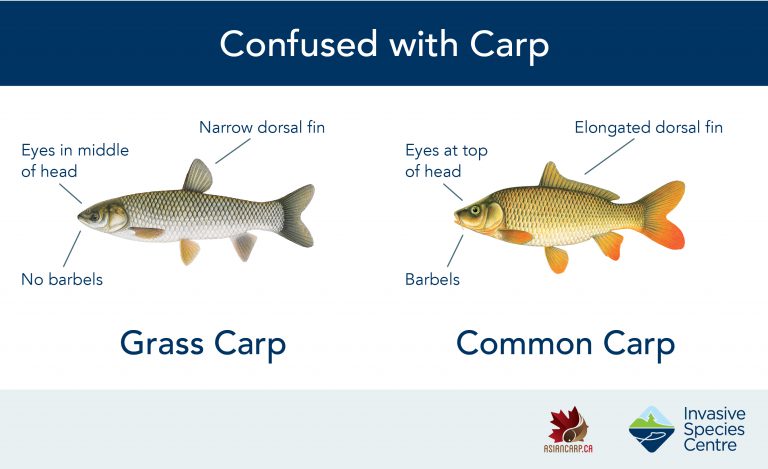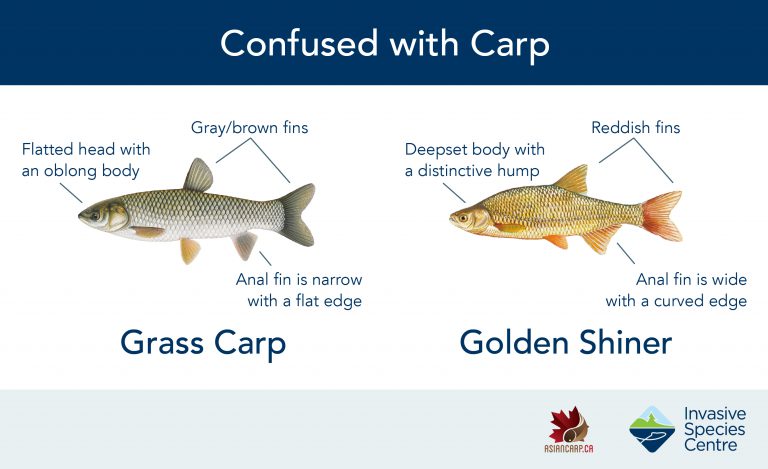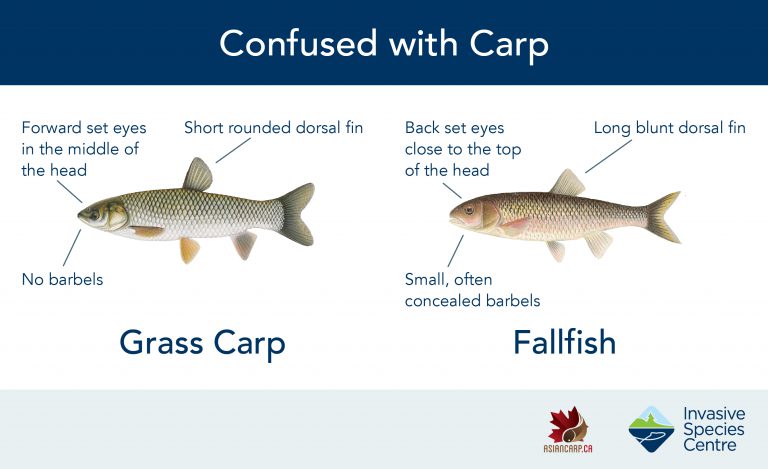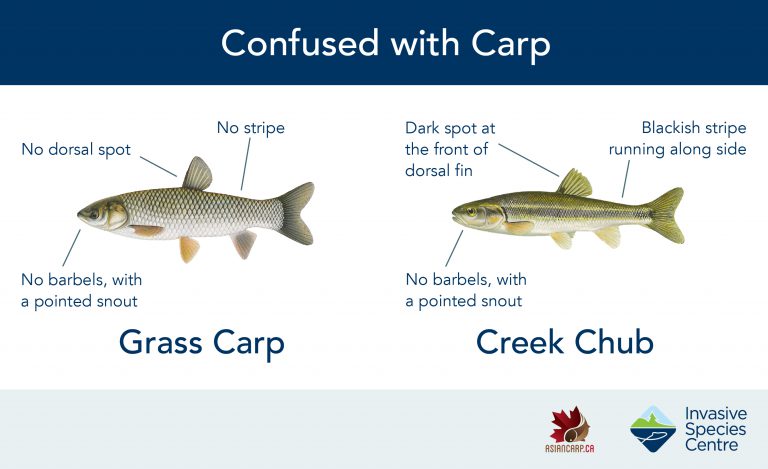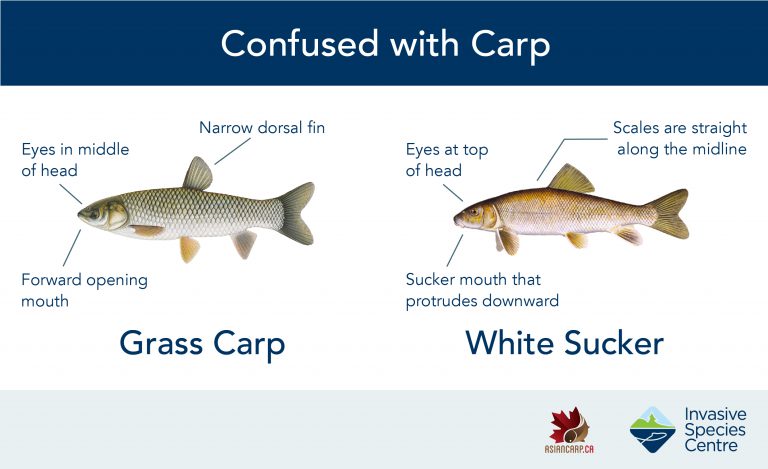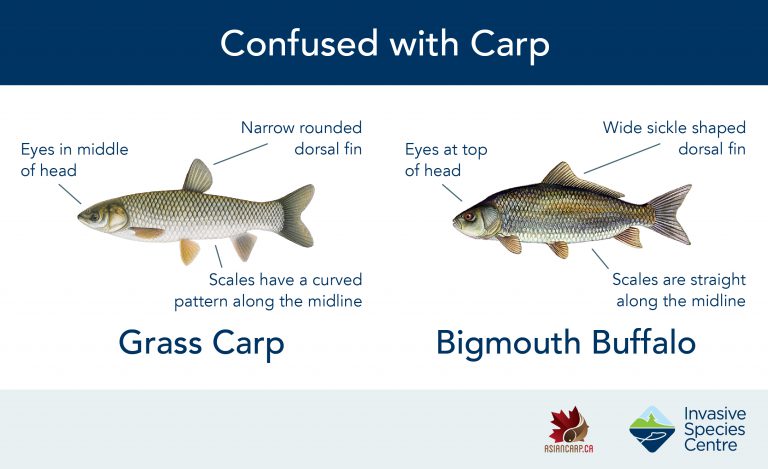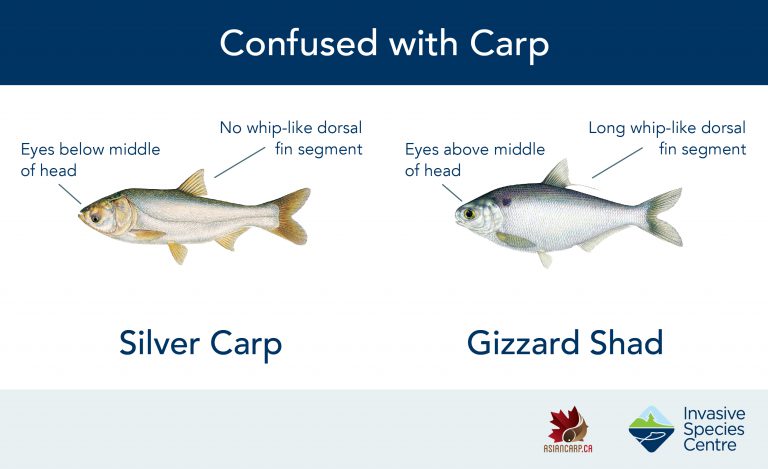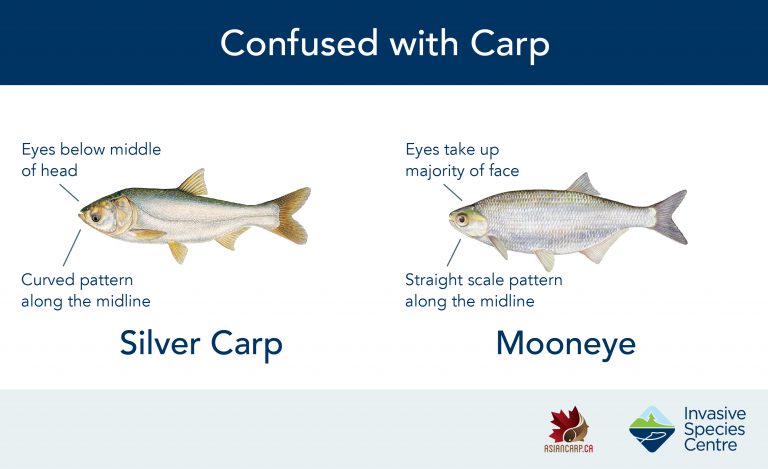In the Baseline Knowledge Survey for Ontario, it was discovered that 26% of Ontarians believe that they can identify an Asian carp. While only 3% of Ontarians know that there are four species of Asian carp. As such, there are many incorrect reports of Asian carps directed to the Invading Species Hotline. This implies that the public, while receiving the message about the risks of Asian carp, are still unable to properly differentiate.
Identifying Asian Carp can be a difficult process due to the number of native look-a-likes. The first step in identifying Asian Carp is ruling out any common look-a-likes.
Here are a few of the main lookalikes that often get confused with carp!

If you are ever unsure of what you catch and you think it might be invasive, report it to the Invading Species Hotline at 1-800-563-7711.
Common Carp
Although they are not native, Common Carp have been established in North America for over 100 years and do not need to be removed or reported if seen. They are deep-bodied and vary in colour from silver to olive-green with brass or grey on the back and sides. The belly is yellowish and lower fins are reddish-orange. Two features that differentiate the Common Carp from the Grass Carp are the presence of whisker-like appendages called barbels near the corners of its mouth and a long dorsal fin that runs down the back half of their body.
Common Carp will often break water during spawning in the spring and less frequently throughout the summer. Sometimes, if they are feeding along shore, their tails may stick out of the water. These traits can be confused as a Silver Carp “jumping” however they do not fully come out of the water like Silver Carp.
Shiner
There are a few species of shiners that get reported as Grass Carp, including Golden Shiner, Striped Shiner, and Common Shiner. All three species are similar in appearance with silver, olive, or golden colourations and are usually between 7 to 15 cm. The key characteristic to differentiate shiners from Grass Carp is that the anal fin of shiners is long and curves inwards where the Grass Carp has a shorter anal fin that has a flat edge. Shiners have reddish fins, deep bodies, and have a distinctive ‘hump’ on its back.
Fallfish
Fallfish are typically dark olive to black on their backs, fading down to silvery white on their bellies. They are usually around 17cm long but can reach lengths of 50 cm. Fallfish have a blunted nose and mouth, whereas Grass Carp have a pointed snout area. Fallfish also have a much longer dorsal fin and eyes that are set much farther back towards the gills, compared to the Grass Carp, which has a narrow dorsal fin and forward set eyes. Though sometimes hidden, the Fallfish also has small barbels at the corners of its mouth, which are absent on the Grass Carp.
Creek Chub
Creek Chub are olive brown with a whitish belly and a dark, pronounced line on its side. On average they are 10 to 15 cm long. Compared to a Grass Carp, the Creek Chub has a more flattened snout and has small barbels in either corner of its mouth. Creek Chub have a blackish stripe along its back with a prominent black dot at the front base of the dorsal fin. Breeding males become an orange hue and gain four to eight large, thorn–like tubercles on their body and fins.
White Sucker
White Sucker are dark green, grey, brown, or black with a light underbelly. They can grow up to 30 to 50 cm long. White Sucker have a straight lateral line running from gills to tail, where a Grass Carp has a curved line. They also have a distinctive sucker mouth that protrudes downwards and has eyes very close to the top of its head, unlike that of the Grass Carp.
Bigmouth Buffalo
Buffalo species tend to be dull brownish olive colour with dusky fins and can reach sizes upward of one metre long. They are not common in Ontario and should be returned to the water whenever caught. The main way to differentiate a Bigmouth Buffalo from a Grass Carp is the distinctive sickle shaped dorsal fin that is tall at the front and tapers down right before the caudal fin, most comparable to the dorsal fin on a Common Carp.
Gizzard Shad
Gizzard Shad are silver blue on the back and silver white underneath and on average are between 28 to 40 cm but can reach up to 50 cm long. The last segment on the Gizzard Shad dorsal fin is long and whip-like, extending past all other dorsal segments, where the carp’s dorsal fins do not. Also, the eye of a Gizzard Shad is above the mouth and lateral line where on a Bighead/Silver carp, the eye is located below the midline and mouth of the fish.
Mooneye
Mooneye tend to have a silvery body with darker fins; on average they are 30 cm long, but can reach lengths of 45 cm. The best way to tell a Mooneye from a Silver Carp is to look at its eye. Mooneye, as the name suggests, has a very large eye that takes up the majority of its face, and is located above the mouth opening. Silver Carp’s eyes are below the mouth opening. Also, Silver Carp have a distinctively curved lateral line where a Mooneye has a straight lateral line.
